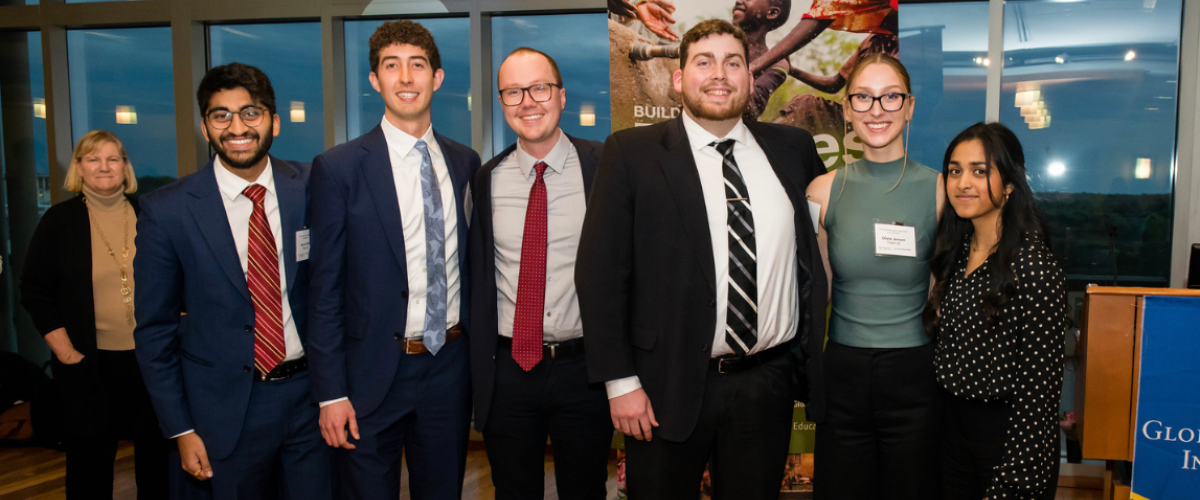Global Health Case Competition: Mock Scenarios, Real World Experience
Ayush Shah, Jameleddine Benhamida, August Glomski, Jason Roycraft, Olivia Jensen and Diya Patel competed as a team in last year's Global Health Case Competition. The group is pictured at Emory University in Atlanta for the national competition.
There’s a viral strain of influenza that’s been discovered in Southeastern Minnesota.
It’s infected poultry and forced farmers to cull their livestock. Consumers worry about price increases and family farms fear for their livelihood. It soon becomes clear the disease is spreading to humans, too. A pandemic looms.
What’s next?
This daunting — and, unfortunately, familiar — mock scenario was posed to students in last year’s Global Health Case Competition, hosted by the Center for Global Health and Social Responsibility and the School of Public Health’s Minnesota Prepared project.
The competition asks teams from around the university to come up with realistic solutions to simulated global health problems. Students explore a hypothetical case over a week’s time and then present solutions to a panel of judges.
Teams are evaluated on the feasibility of their strategies as well as how creative, sustainable and equitable their approaches are.
In the case of the viral influenza scenario, students needed to create strategies that would slow transmission of the disease and mitigate potential consequences. The case stated they had been summoned by the Minnesota Department of Health to come up with a plan.
“We only get a week to basically become mini experts in the field of the case that they give us,” said Jameleddine Benhamida, a UMN Medical School student who was part of the winning team in last year’s competition. “The first couple of days was really just reading and doing huge lit dives to really understand what we were getting ourselves into.”
Benhamida’s team included Ayush Shah, UMN Medical School; Olivia Jensen, UMN College of Liberal Arts; Diya Patel, College of Continuing and Professional Studies; August Glomski, UMN School of Public Health; and Jason Roycraft, UMN Humphrey School of Public Affairs. The group advanced to the national competition at Emory University in Atlanta, where they placed fourth.
“Our presentation took a three-layered approach: we did prevention, mitigation and then focused on treatment for people if they did contract the virus,” said Jensen, BA ‘23. “One thing that really helped us, especially with the Minnesota competition, was focusing on vulnerable populations.”
Shah, a current UMN Medical School student, was the team’s captain. He emphasized the importance of the interdisciplinary aspect of the competition. The teams need to include participants from three or more UMN schools.
“You’re taught to think a certain way in medical school, and I’m sure in other respective grad programs. And to see how different individuals from different schools think about a certain problem was really satisfying — it opened up my eyes to different ways to approach a question.”
The idea of working with rural populations wasn’t completely new for Roycraft, who is pursuing a master’s degree at UMN’s Humphrey School of Public Affairs. The semester prior to the competition, he had worked on a program evaluation for the Upper Midwest Agricultural Safety and Health Center (UMASH).
One of the case competition judges was Jeff Bender, DVM, MS, the director of UMASH. Other final round judges included Deborah Radi, MBA, from the Minnesota Department of Health and Montserrat Torremorell, DVM, PhD, professor in the College of Veterinary Medicine.
“That experience (with UMASH) gave us a lot of strategies on how to do communication for rural communities and how best to frame public information to those communities,” said Roycraft.
Presenting in front of the competitions’ judges provides an opportunity for students to network with experts in global and public health.
The team also reached out to Minnesota farmers, UMN faculty and other experts to gain insights. This collaboration, coupled with the help of their coach, Dr. Whitney Waldsmith, an assistant professor of veterinary clinical sciences at the UMN College of Veterinary Medicine, helped them to better understand the case and what strategies might be most effective.
“This is the type of supplemental learning that you’re never going to get in your program regardless of where you’re going or what kind of school you’re in,” said Benhamida. “I really do think the ability to work with a team of individuals that you didn’t know before to address a problem that, in our cases, both were very plausible, very real life scenarios, is something that you don’t really get in school.”
